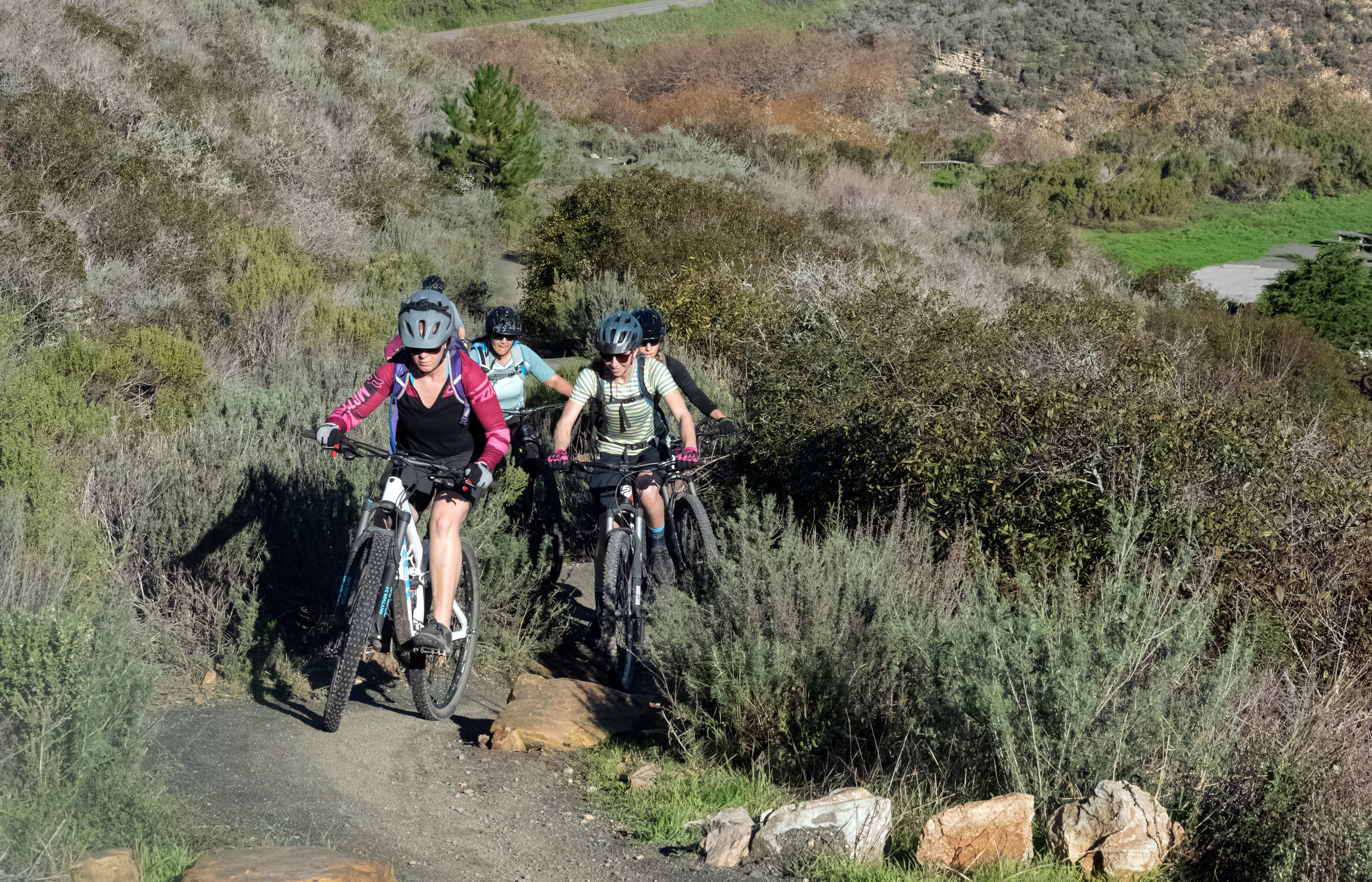With her hands tightly gripping the handlebars and her eyes on high alert, 29-year-old mountain biker Alexandra Anderson carefully and quickly adjusted to each new turn and patch of rocks on the rugged downhill terrain of Madonna Mountain.
“Your bike is actually better at faster speeds if you have a full suspension bike,” Anderson said. “If you go slower, then you can get hung up and you’re more likely to crash, but if you just relax your body and let gravity do it, you’ll be fine.”
Anderson is a member of the Facebook group “SLO Dirt Girls,” a community of over 280 women who share a love for mountain biking. Anderson has raced at the pro level, but her community prides itself in welcoming anyone with little to no experience on the biweekly rides.
“SLODirt Girls is a cool way to bring all mountain biking girls together, and within that group you grow a large sense of community, but you can also find the niche kind of riding that you want to do group rides with as well,” Anderson said.
As clarified by Anderson, not all mountain biking is flying downhill at an average of 35 to 40 mph. For many members of SLO Dirt Girls as well as Anderson, mountain biking is about climbing for hours, the sense of community, trust within each other and shared adventure.
Danilu Ramirez is a leader within SLO Dirt Girls and the mountain biking community overall in San Luis Obispo. She is a trek women’s advocate and has used the SLO Dirt Girls platform to bring in skills clinics for beginners in the area.
“Girls would say, ‘Well I’d never be on my bike if we weren’t having these rides,’ and that’s when I’m like, ‘Yes!’” Ramirez said.
Ramirez is a trained docent on private land owned by the land conservancy at the Pismo Reserve. In the past, the group has held rides at the reserve that had larger turnouts, about 15 cyclists on each ride.
“It gave everyone a safe feeling because a lot of the trails are easier,” Ramirez said. “Sometimes, people get nervous with other people running or hiking or biking and there’s a lot going on, but at Pismo, it was just us.”
Ramirez said the largest challenges they face in recruiting more women for the sport is the high risk of injury. For many of her friends who are mothers, she said they feel it is too dangerous.
“I’ve heard from women that have kids it’s like, ‘Well I have to pick up my kids, you know, I can’t have broken arms,’ or ‘I need to do all this stuff for my family,’” Ramirez said. “I get that, too. For me that’s not a factor, but I get that women have told me before that they can’t afford to break something. Even for work, we have women that are engineers and architects and they don’t want to be broken for work.”
Anderson and Ramirez said although it is a generalization and there are exceptions, they have seen that men in the sport typically engage in riskier behavior on the bikes, while women tend to be more cautious. This becomes extremely apparent in co-ed competitions.
“[In the race] there’s usually five women and 200 men – it’s my worst nightmare,” Ramirez said. “I just wake up sweating the night before because they have no mercy when they pass you. They’ll knock you over; some guys are really mean.”
Cal Poly alumna and SLO Dirt Girls member Liz Schteiden said SLO Dirt Girls is a great community for beginning riders because the rides tend to be more casual.
“There’s a little less pressure sometimes than when you’re riding with a group of guys,” Schteiden said. “So sometimes it’s also more approachable, especially for newer riders.”
Schteiden said she tends to be more cautious on the bike, but that she loves the sport because it forces her to face her fears.
“I think it’s a balance of overcoming your fears and challenging yourself to take risks but also managing those risks as to not get hurt,” Schteiden said. “I think that sometimes I can be a little bit more cautious than others, but it’s been fun to find where that balance is and push my boundaries and grow in the sport.”
For many members of SLO Dirt Girls, their love for the sport all comes down to adventure and building a stronger connection with other cyclists and the outdoors.
“It’s not just great for your physical body, but your mental capacity as well,” Anderson said. “You can let go of stress, forget about anything that might be bothering you for the time being and let it all go because you’re out there on your bike in nature. Seriously, what could you worry about?”
According to Anderson and Ramirez, a beginner should never purchase a “cheap” mountain bike. Instead, Ramirez recommended finding a friend who will allow them to borrow a bike for a ride or to reach out on the SLO Dirt Girls page.
“Don’t go buy a bike from Walmart for $300 under [any] circumstances,” Ramirez said.
Schteiden said she finishes each ride with a new skill learned and more love for the sport.
“You come off the end of the day and you’ve covered so many miles and seen so much, but you’ve also had a really good time doing it,” Schteiden said. “I think that’s kind of what I love the most about it.”

